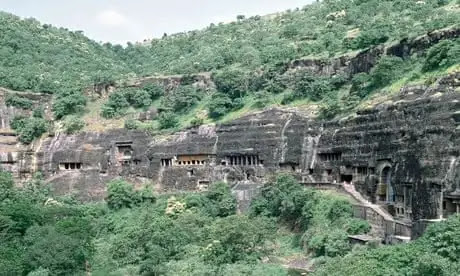Ajanta caves carry a living testimony in India's history. From 200 to 280 BC, it is believed that Ajanta caves were built on cut trees, cut for 850 years in deep cut cliffs.
Ajanta caves are like crescendo in the mountains. To go through the deep forests of the mountains, Ajanta is unknown.
A little below the Ajanta Cave, it is seen that the river Waghora is full of natural beauty. Ajanta caves are approximately 30 caves of roughly 30 caves. There are 5 caves and there are 28 caves resting rooms. Some construction of caves remains unfinished.
It looks like the builders will take a break and start working after a while. Cave has painted the story of the Buddha, the biography of the Buddha, flowers, creepers, leaves, various types of sculptures and murals, etc. Bodhisattva, Avalokiteshvara, Padmapani, etc. are the best pictures of Ajanta.
The origin of the Ajanta cave is secularism. The construction of 29 caves was started in about 200 BC. But in 650 AD it was abandoned.
Then the caves were long forgotten by the deep forests. At one point in 1819, Captain John Smith of the Madras Regiment saw his abandoned mugs for his hunting with the army and hunting tigers on the banks of the Waghora river. And in 1819 it was discovered again in Newark, the forgotten caves. It is also published in the Annual Report of the Royal Asiatic Society.
In 19830 Ajanta Cave ( UNESCO - United Nations Educational, Scientific and Cultural Organization) is listed on UNESCO World Heritage Site.
The description of Ajanta Caves is also found in the travelogue of Chinese traveler Hiuen Tsang.BENGALI TRANSLATION
অজন্তা গুহাসমূহ ভারতের ইতিহাসের এক জীবন্ত সাক্ষ্য বহন করে । খ্রিস্টপূর্ব ২০০ থেকে ৬৫০ খ্রিস্টাব্দ পর্যন্ত , সহ্যাদ্রি পর্বতে এই দীর্ঘ ৮৫০ বছর ধরে গভীর খাড়া গিরিখাত কেটে কেটে তৈরি করা হয়েছিল অজন্তার গুহাগুলি বলে মনে করা হয় ।
অজন্তা গুহাগুলি পাহাড়ের কোলে অর্ধচন্দ্রাকৃতির ন্যায় বিরাজমান । পাহাড় বেয়ে ঘন বনপথ দিয়ে যেতে হয় অজন্তায় । অজন্তা গুহার খানিকটা নীচের দিকে তাকালেই দেখা যায় বাঘোরা নদী , এই নদীটি প্রাকৃতিক সৌন্দর্যে ভরপুর ।
অজন্তা গুহাসমূহ প্রায় মোটামুটি ৩০ টি গুহার সমষ্টি ।
৫ টি গুহাতে উপাসনালয় আছে এবং ২8 টি গুহা বিশ্রামালয় অর্থাৎ আরামকক্ষ ।কয়েকটি গুহার নির্মাণ কার্য অসমাপ্ত রয়ে গেছে । যা দেখলে মনে হয় নির্মাণকারীরা বিশ্রাম নিতে গেছেন কিছুক্ষন পরেই এসে কাজ শুরু করে দিবেন । গুহাগুলিতে আঁকা আছে জাতকের গল্প, বুদ্ধের জীবনী, ফুল, লতা, পাতা, নানা ধরনের ভাস্কর্য ও মুরাল চিত্র ইত্যাদি । বোধিসত্ত্ব, অবলোকিতেশ্বর, পদ্মপাণি প্রভৃতি চিত্র গুলি অজন্তার সেরা চিত্র ।
অজন্তা গুহাচিত্রের মূলে আছে ধর্মনিরপেক্ষতা । ২৯ টি গুহার নির্মাণ কার্য প্রায় ২০০ খিস্টপূর্বাব্দে শুরু করা হয়েছিল । কিন্তু ৬৫০ খ্রিস্টাব্দে তা পরিত্যক্ত হয় ।
এরপর গুহাগুলি দীর্ঘকাল গভীর অরণ্যের আড়ালে বিস্মৃত অবস্থায় পড়েছিল । ১৮১৯ সালের কোনো এক সময় মাদ্রাজ রেজিমেন্টের ক্যাপ্টেন জন স্মিথ তার সেনাবাহিনীকে নিয়ে বাঘোরা নদীর তীরে বাঘ শিকারের উদ্দেশ্যে গিয়ে পরিত্যক্ত গুহাস্তুপগুলি দেখতে পান । এবং ১৮১৯ সালে আবার নতুনকরে আবিষ্কৃত হয় ,বিস্মৃত হয়ে যাওয়া এই গুহাসমূহ । রয়্যাল এশিয়াটিক সোসাইটির বার্ষিক রিপোর্টেও এটি প্রকাশিত হয় ।
১৯৮৩ সালে অজন্তা গুহা (UNESCO-United Nations Educational, Scientific and Cultural Organization) ইউনেস্কোর WORLD HERITAGE SITE এর তালিকাভুক্ত হয় ।
চীনা পরিব্রাজক হিউয়েন সাঙ - এর ভ্রমনলিপিতেও অজন্তা গুহাসমূহের বর্ণনা পাওয়া যায় ।











